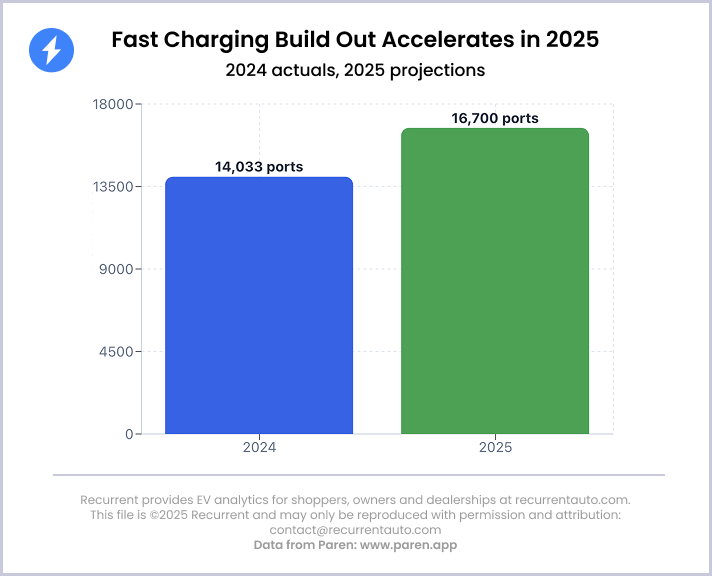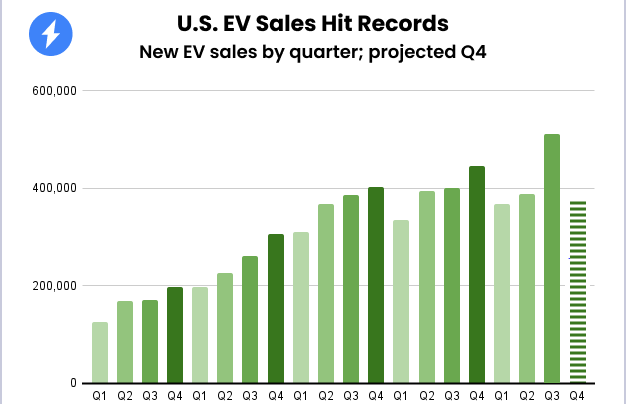New and Used EV Sales Records
As of September 30, 2025, all federal tax credits for used, new, and leased electric vehicles ended. It was no surprise, then, that Q3 saw record sales for new and used PHEVs and BEVs. Total EV sales are at 10.36% through Q3 compared to 9.6% for 2024. The Q3 record beat the prior peak set in Q4 2024 by nearly 20%. September, the country’s strongest month of EV sales ever, saw 14% penetration in the new market.
.png)
Tesla Market Share Cut In Half
Looking at new EV sales through Q3 this year, Tesla led the pack, even though its market share has fallen from a peak of 62.8% in 2020 to 32% so far this year.
The Chevrolet Equinox, which swept the market when it was released in 2024, came in third place after the Model Y and Model 3, and helped win GM second place in terms of volume. Hyundai group came in third, largely on the success of the Ioniq 5, which more than doubled its quarterly sales from Q2 to Q3.
Stellantis, which has not been seen as an EV leader, came in fourth, thanks to success with the Jeep Grand Cherokee and Wrangler 4xe PHEVs, which took first and second place in new PHEV sales volume through Q3.
%20(1).webp)
With the tax credit off the table, many skeptics and experts alike assumed that EV sales would zero out in Q4. However, reports from dealers on the ground suggest that there are still shoppers, and it is vehicle supply, rather than demand, that seems constrained.
Used EV Market Pricing Splinters After Tax Credits
In aggregate, used EV prices and supply have not actually changed that much since September 30, but if you’re in the market for one, different price points are behaving differently in the market.
.png)
Recurrent has been tracking price point changes for a wide spectrum of the used EV market on a daily basis from the beginning of September to the end of October to watch for the impact of the removal of new and used EV rebates.
At the low end of the market (2019 Hyundai Ioniq, 2018 Tesla Model 3), it appears that used EV pricing has softened in the three weeks since the rebates were removed. Whether this is a temporary phenomenon due to dealers trying to liquidate units, or a longer-term market equilibrium, is yet to be determined.
At the higher end of the used market (largely premium brands and 0-2 year old vehicles), the opposite seems to be true. As new models have effectively become more expensive because of the loss of $7500 new rebates and the beginning of tariff impacts, relatively new used cars are getting more expensive.
Public Fast Charging is Keeping Up with EV Growth
The state of public charging is inextricably linked to EV adoption, as range anxiety, followed by public charger availability, remain the biggest concerns that Americans cite about electric vehicles.

However, investment and build out of new ports has accelerated in 2025. Paren, a charging data aggregator and analytics company, estimates 17K new ports this year. On a baseline of 51,000 existing ports, this represents 33% growth. That is comparable to, but higher than, the 31% increase in EVs on the road over the year.
But the bigger story is the opening of the Supercharger network to most EV brands over 2025 or in early 2026. For non-Tesla EV drivers, this year has seen major improvements in fast charging access, with many of Tesla’s 2,821 stations and 34,499 ports now open to drivers from other brands. The Tesla network includes more than 50% of all domestic charging ports, so this is a massive increase in charging availability.
Note: most 2025 model EVs do require an adapter to connect to Tesla’s NACS charging stations.
Finally, the federal NEVI program (National Electric Vehicle Infrastructure) has been a rollercoaster with funding stops and starts over 2025.
However, uneven NEVI network progress should not affect the overall trajectory of public fast charging, which research firm Wood Mackenzie projects “will grow at a “robust” 14% compound annual rate through 2040,” beating out CAGR forecast for the worldwide market. Although the rollout of NEVI chargers has been slowed by policy flux and program complexity, to date, NEVI stations make up less than 1% of available public stations and ports.
Expect private companies to carry the major burden of charging infrastructure, especially as the EV charging credits (Alternative Fuel Vehicle Refueling Property Credit) have not yet expired. Businesses or tax exempt organizations can claim a credit of 6% of the cost of the property (with a maximum credit of $100,000 per item) for each charging port, fuel dispenser, or storage property they install. Additional requirements allow for higher credit percentages.
Previous Reports
Q2 2025
This report on new EV market trends builds on years of data-driven coverage of the used EV market. The first edition covers the 2025 model year.
Top Takeaways for the 2025 EV model year:
- The average EV range in 2025 has increased 4% over the last year, to 293 miles.
- Fast charging speeds have improved 7% over the 2024 model year.
- With larger and heavier EVs becoming more common, the average vehicle efficiency has dropped by 16% since 2018, meaning that much larger battery packs are being used to deliver marginal range increases.


-p-500.png)



